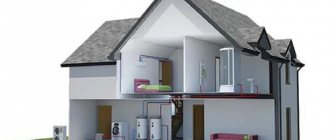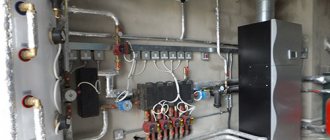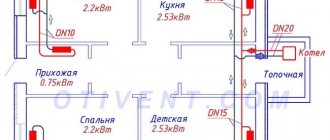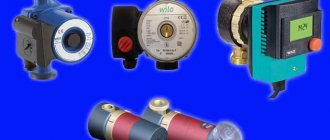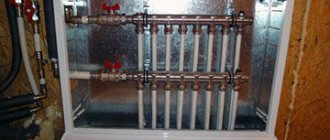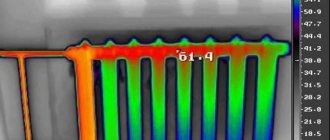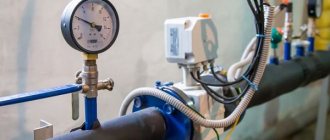Here you will learn:
- Purpose of the thermal valve
- Advantages and disadvantages
- Characteristics of thermal valves
- Valve operating principle
- Types of devices
- How to choose
- How to install correctly
- Rules for adjusting the operation of the device
- Expert advice
The thermostatic valve for a heating radiator provides regulation of the amount of coolant flowing through the radiator. Adjustment can be done either manually or automatically. This valve saves heating costs.
Purpose of the thermal valve
The valve solves two problems: maintains the room temperature at a comfortable level and saves energy.
But in order for it to really cope with such functions, you need to understand in what cases the device is appropriate and how to install it correctly.
If in the middle of winter there is a need to open the windows so that the temperature in the room drops to an acceptable level, a thermostat is definitely needed. But it won’t help when the radiators are barely warm—it will probably make it even colder.
In the second case, it is better to try to regulate the temperature in the room differently: change the volume of coolant in each radiator, adjust the operation of the boiler (for a large area), select the optimal circulation pump or adjust the operation of the existing one.
The price of a thermostat ranges from several hundred rubles (200-600), so re-equipment of the heating system will not be expensive. But there are also expensive models
As a temporary measure, control valves can be used. But it is not recommended to use ball valves for these purposes.
Kinds
Thermostatic valves are made of stainless steel (expensive, but durable), nickel-plated or chrome-plated bronze, nickel-plated brass. In order for the thermostatic valve to perform such functions as maintaining the temperature in the rooms at the most comfortable level and saving energy, it is necessary not only to follow all the rules for installing the device, but also to choose wisely:
- direct option - for standard heating devices;
- angular (horizontal/vertical) – for schemes with bottom piping.
Depending on the method of regulation, the valves produced for radiators are represented by mechanical and automatic devices. In the first case, the mechanism rotates manually, narrowing the coolant flow in the pipes. Automatic models record and correct the flow of thermal fluid independently.
Advantages and disadvantages
The advantages of installing thermostatic valves in the heating system include the following factors:
- Energy independence of the device.
- Compactness.
- High precision temperature control.
- Easy to operate and highly reliable.
- Aesthetic appearance.
- The optimal combination of price and functionality.
The disadvantages of using thermostatic valves are:
- Difficulty setting up.
- There is a danger of the thermal head malfunctioning under the influence of a draft or a nearby stove.
Purpose of shut-off valves
Among ordinary people, the term “faucet” is usually applied to any device for controlling the flow of liquid that is equipped with a handle. In the technical literature, taps are called shut-off valves, with the help of which you can achieve only complete blocking or opening of the coolant flow. These devices cannot be adjusted. For this purpose, there are other types of products - valves and radiator shut-off valves. Most often, the inlet pipe to the radiator is equipped with control valves.
Its functions are as follows:
- Possibility to turn off the battery. The reason could be a variety of reasons.
- Shutting off the coolant supply for flushing and testing activities.
- Manual or automatic adjustment of coolant supply. This allows you to reduce or increase the temperature of the radiator.
The range of functions performed may differ for different types of fittings. When starting to independently arrange a heating system, it is important to familiarize yourself with the design features of all types of taps that may be encountered during the installation of heating radiators.
Characteristics of thermal valves
For your information, here are a number of basic technical characteristics of thermostatic valves:
- The maximum operating pressure level is 1.0 MPa.
- Pressure testing before commissioning is 1.5 MPa.
- The maximum operating temperature is +110 ºС.
- The maximum permissible ambient temperature is +50 ºС.
- The valve capacity is from 1.6 to 2.5 m³/h.
- Temperature control range - +20…+60 ºС.
- Response time: 25 min.
- MTBF with manual control - 8000 cycles.
What materials are they made from?
Corrosion-resistant metals are used to make the thermostatic valve body:
- Brass.
- Bronze.
- Stainless steel.
Additionally, the surfaces of brass products are nickel-plated, and the bronze body is either also nickel-plated or coated with a layer of chrome.
Valve operating principle
The valve with thermal head is designed to maintain the set temperature in offline mode. The device operates on the principle of compression-expansion of gas or liquid depending on the environment. The thermostat can be built-in or located remotely.
The thermostatic valve has a bellows - a corrugated movable container that is filled with a heat-sensitive agent. When the surrounding air heats up, the agent increases in volume and puts pressure on the valve's shut-off cone, initiating its closure. When cooling, the reverse process occurs - the agent cools, the bellows decreases in volume and the valve opens.
There are gas and liquid bellows. Gas agents are more sensitive to environmental changes, but are more expensive and more difficult to produce. Liquid ones are less sensitive, but cheaper. The difference in temperature control accuracy is about 0.5 degrees, which is not significant.
Thermostatic heads
There are three types of thermostatic elements for heating thermostats - manual, mechanical and electronic. They all perform the same functions, but in different ways, provide different levels of comfort, and have different capabilities.
Manual thermostatic heads work like a regular faucet - you turn the regulator in one direction or another, allowing more or less coolant to flow through. The cheapest and most reliable, but not the most convenient devices. To change the heat transfer, you must manually turn the valve.
Manual thermal head - the simplest and most reliable option
These devices are quite inexpensive, they can be installed at the inlet and outlet of a heating radiator instead of ball valves. Any of them can be adjusted.
Mechanical
A more complex device that maintains the set temperature automatically. The basis of this type of thermostatic head is a bellows. This is a small elastic cylinder that is filled with a temperature agent. A temperature agent is a gas or liquid that has a high coefficient of expansion - when heated, it greatly increases in volume.
Thermostat device for a heating radiator with a mechanical thermostatic head
The bellows supports the rod, which blocks the flow area of the valve. Until the substance in the bellows heats up, the rod is raised. As the temperature rises, the cylinder begins to increase in size (gas or liquid expands), it puts pressure on the rod, which increasingly blocks the flow area. Less and less coolant passes through the radiator, and it gradually cools down. The substance in the bellows also cools down, due to which the cylinder decreases in size, the rod rises, more coolant passes through the radiator, and it begins to warm up a little. Then the cycle repeats.
Gas or liquid
With such a device, the room temperature is fairly maintained at exactly +- 1°C, but in general the delta depends on how inert the substance in the bellows is. It can be filled with some kind of gas or liquid. Gases react faster to temperature changes, but are technologically more difficult to produce.
Liquid or gas bellows - not much difference
Liquids change volumes a little more slowly, but are easier to produce. In general, the difference in the accuracy of temperature maintenance is about half a degree, which is almost impossible to notice. As a result, most of the presented thermostats for heating radiators are equipped with thermal heads with liquid bellows.
With remote sensor
The mechanical thermostatic head should be installed so that it faces the room. This way the temperature is measured more accurately. Since they are quite large in size, this installation method is not always possible. For these cases, you can install a thermostat for the heating radiator with a remote sensor. The temperature sensor is connected to the head using a capillary tube. You can place it at any point where you prefer to measure air temperature.
With remote sensor
All changes in heat transfer from the radiator will occur depending on the air temperature in the room. The only disadvantage of this solution is the high cost of such models. But the temperature is maintained more accurately.
Electronic
The electronic thermostat for a heating radiator is even larger in size. The thermostatic element is even larger. In addition to the electronic filling, it also contains two batteries.
Electronic thermostats on batteries are large in size
In this case, the movement of the rod in the valve is controlled by a microprocessor. These models have a fairly large set of additional functions. For example, the ability to set the room temperature by the hour. How can this be used? Doctors have long proven that it is better to sleep in a cool room. Therefore, at night you can program the temperature lower, and in the morning, when it’s time to wake up, you can set it higher. Comfortable.
The disadvantage of these models is their large size, the need to monitor battery discharge (enough for several years of operation) and high price.
Types of devices
Today there are several types of thermostatic valves. Among them the most popular are:
- Mechanical. They require manual adjustment of the coolant supply.
- Semi-electronic. They are controlled by a special thermal head with a bellows device.
- Electronic. Control is carried out using a remote temperature sensor.
Mechanical thermostats
The main advantages of mechanical structures are low price, smooth and precise functioning, and ease of use. During their operation, you do not need to use auxiliary energy sources. Thanks to their modification, it is possible to manually regulate the volume of coolant entering the radiator, controlling its heat transfer. In such devices you can accurately set the degree of heating.
The main disadvantage of mechanical equipment is the lack of markings for adjustment, so its adjustment is carried out mainly by trial and error. The product consists of:
- a bellows filled with a liquid or gaseous mixture;
- regulator;
- drive.
The main role is played by the substance with which the bellows is filled. When the position of the thermostat lever changes, it enters the spool, adjusting the rod. The latter, under such influence, blocks the passage, thereby limiting the entry of coolant into the radiator.
Electronic temperature sensors
Electronic devices are more complex, because they are based on a programmable microprocessor. Thanks to it, it becomes possible to set the required temperature in the room. To do this you need to press several buttons. There are multifunctional models with which you can control a mixer, boiler or pump.
The operating principle and design of electronic units are almost no different from mechanical products. Inside such equipment there is a substance that reacts to temperature changes. As the temperature increases, it expands and pressure is generated, under the influence of which the rod begins to move, automatically closing the valve. As the temperature decreases, the substance contracts, causing the valve to open.
The bellows has high strength and a long service life. The substance can withstand repeated compression throughout its entire operational period of several decades. There are the following types of electronic designs:
- Closed valves for heating batteries cannot automatically determine the temperature value, so they are adjusted manually. You can set the temperature values, as well as their permissible fluctuations.
- Open products that can be programmed. So, when the temperature decreases, the operating mode changes. In addition, it is possible to adjust the timer and configure the operation of certain modes. In most cases, such designs are in demand on an industrial scale.
Electronic products operate using batteries or a rechargeable battery sold complete with a charger. Semi-electronic valves are an ideal option for home use. They are equipped with a digital display that shows the temperature in the room.
Gas and liquid valves
When operating the regulator, gaseous or liquid substances can be used as a temperature control element. Because of this, all devices are divided into liquid and gas.
The latter have a long service life (at least 20 years). This is due to the fact that gaseous substances contribute to a clearer and smoother regulation of temperature in the room. The products are equipped with a sensor that detects temperature. The gas bellows reacts faster to temperature changes in the room.
Fluid devices more accurately transmit internal pressure to driving mechanisms. When choosing a product, most consumers focus on the service life and quality of the product. There are several types of structures:
- remote;
- having a built-in sensor.
The latter are often installed horizontally. This is due to the fact that they need air circulation around them. It is advisable to use remote units in the following situations:
- with a vertically located thermostat;
- when heating equipment is located at a distance of less than 10 and more than 22 cm from the window sill;
- the radiator is covered with thick curtains;
- battery depth is more than 16 cm;
- The radiator is located in a niche.
In such situations, the built-in thermostat will not function correctly, so most often a remote one is used. Most often, sensors are placed at right angles to the body. When installed in parallel, their values will be lost under the influence of the heat emanating from the battery.
Principle of operation
Thermostatic valves are basically a cylinder filled with a heating agent (this plumbing element is called a bellows). Liquid or gases can be used as a thermal reagent. But nothing will do for this. The volume of coolant should depend on the temperature. There are also devices with solid components. However, they are not popular due to their long reaction time.
During the heating process, the working substance begins to increase in volume, thereby stretching the cylinder. The latter begins to put pressure on the piston, which in turn sets the shut-off cone on the valve in motion.
The cone completely or partially blocks the flow of the heat agent, causing the working substance in the thermostatic head to begin to cool. During the cooling process, the volume of the substance decreases, and as a result, the elastic element raises the locking cone. The coolant will again flow into the heating radiator, and the head will heat up again.
Thus, thermostatic valves help to precisely control the temperature with high accuracy (up to one degree Celsius).
How to choose
The thermostat is selected according to the operating characteristics of the heating system. The device must:
- Withstand pressure in the range of 16–40 bar and temperatures up to 200 °C.
- Be made of corrosion-resistant materials that are resistant to mechanical stress.
- Match the diameter with the size of the pipeline.
- Match the thread parameters on the pipe.
Popular manufacturers
Thermostats manufactured by the following companies are considered the most reliable and durable:
- Danfoss (Denmark). Devices from this manufacturer, despite their fairly low price, have an improved design. They are equipped with a flow stabilizer, so they operate silently. They do not become clogged when working with any contaminated coolant, since their rod stroke is 1.5 times greater, and the performance adjustment window has a larger cross-section.
- Oventrop (Germany). The variety of standard sizes of thermostatic fittings from Oventrop allows you to choose the ideal model for any engineering system. Excellent regulating qualities, high product reliability are combined with an aesthetic appearance.
- Luxor (Italy). Luxor thermostats are suitable for heating systems where the coolant is hot water. They are equipped with a thermostatic spindle that allows pre-setting of the flow.
Rules for the use and installation of thermal valves for heating
For conventional heating systems, two-pipe thermostatic valves are used.
When choosing the type of control valve for a heating system and the method of its installation, the following conditions are taken into account:
- For systems of conventional construction, where two pipes and circulation pumps are used, simple two-pipe thermostatic radiator valves are used.
- For gravity circuits with one pipe - single-pipe devices with an increased throughput channel.
- Take into account the direction of coolant flow - from above or from the lower channel.
- The shut-off valve for the radiator is mounted at a distance of 60-40 cm from the lowest point of the room.
- The direction of connection of the shut-off valves is selected in accordance with the flow markings on the body.
To ensure the tightness of the threaded connection in hard-to-reach places where it is difficult to use FUM tape, you can use special pipe heat-stable silicones.
Among the well-known products on the market for adjusting heaters are: Italian products RBM and ICMA, devices from the German company PROFACTOR, Chinese thermal valves UNO New.
How to install correctly
They install a thermostat for a heating radiator at the inlet or outlet of the heating device - there is no difference, they work with equal success in both positions. How to choose a place to install?
According to the recommended installation height. There is such a clause in the technical specifications. Each device is configured at the factory - they are calibrated to control the temperature at a certain height and usually this is the upper radiator manifold. In this case, the heat regulator is installed at a height of 60-80 cm; it is convenient to adjust it manually if necessary.
Installation diagrams for heat regulators for radiators
If you have a bottom saddle connection (pipes fit only from the bottom), there are three options - look for a device that can be installed at the bottom, install a model with a remote sensor, or reconfigure the thermal head. The procedure is simple; the description must be in the passport. All you need is to have a thermometer and at certain moments turn the head in one direction, then in the other direction.
Installation is standard - on fum tape or linen winding with packaging paste
The installation process itself is standard. The valve has a thread. The appropriate fittings are selected for it or a matching thread is cut on the metal pipe.
One important point that those who want to install a thermostat for a heating radiator in apartment buildings should remember. If you have a single-pipe installation, they can only be installed if there is a bypass - a section of pipe that stands in front of the battery and connects the two pipes to each other.
If you have a similar wiring (there may not be a pipe on the right), a bypass is required. The thermostat should be installed immediately behind the radiator
Otherwise, you will regulate the entire riser, which your neighbors will definitely not like. For such a violation, a very substantial fine can be issued. Therefore, it is better to install a bypass (if not).
Features of the thermal valve
It was mentioned earlier that it is universal, that is, any type of thermal head can be installed on it. However, despite this, it has two varieties. They depend on which heating system the tap is to be used in. single-pipe or double-pipe.
The types of thermal valves should not be neglected, since installing a valve in a one-pipe system for a two-pipe system. The radiator will not warm up well. The reason for this is that the shut-off valves for a 2-pipe system have high hydraulic resistance. In fact, it is twice the value of valves for a 1-pipe system. To achieve such resistance, manufacturers make a small flow area. It also allows you to reduce the pressure on the valves and balance the pressure in the system. Because of this, under conditions of low pressure (typical of a 1-pipe system), little coolant flows through the tap.
For 1-pipe systems, those valves are suitable whose flow capacity is equal to or greater than 3.
Mounting an electronic thermostat on a battery is very simple. To do this, perform the following steps:
- Shut off the riser and drain the water.
- A piece of pipe is cut off from the radiator. Its length must match the length of the thermostatic valve. In essence, the pipe is cut in one place.
- Dismantle the part of the pipe that remains in the radiator. These steps are not performed if the heating system is just being created or if there is a tap with the same dimensions as the required valve.
- Unscrew the fitting with the American connection from the thermal valve.
- The fitting is fixed in the radiator, and the base of the valve is fixed on the pipe.
- Apply the tap to the fitting in the radiator and tighten the American one. The valve should be positioned so that the stem “looks” to the side.
- Fix the electronic or mechanical thermal head.
The installation features are as follows:
- The thermostat is usually placed on the inlet pipe. In this case, the arrow on it must coincide with the direction of movement of the coolant;
- The electronic device must always be kept horizontal. It is prohibited to place the thermal head above the pipe. This is because the heat from the pipe will heat up the cylinder and cause unnecessary shutdown of the radiator. The consequence is a cold room;
- Most electronic and mechanical regulators are configured for installation at a height of 40-60 cm. If you place them at a height of 10-15 cm (bottom connection of the battery), the room will be too warm. The problem with the bottom connection can be solved by reconfiguring the thermostat, using a remote sensor, or purchasing a specially designed regulator;
- If the heating system is single-pipe, then the inlet and outlet pipes must be properly connected with an additional pipe. That is, it is necessary to create a bypass.
Rules for adjusting the operation of the device
After installation, you need to adjust the operation of the device. To do this, we first close the windows and doors - we insulate the room to prevent heat leakage.
Then we proceed like this:
- We turn on the heating.
- We set the valve to the position of maximum heat transfer and measure the temperature.
- We are waiting for the room temperature to rise by 5 degrees and become constant.
- Close the valve and wait for a comfortable temperature.
- Then we open the thermostat a little bit until we hear the sound of passing water. The body of the device itself should become warmer.
- The last point needs to be remembered.
In a private home, air must be bleed from the batteries before adjustment. In this case, maximum care must be taken to avoid the release of hot steam.
When more than three batteries are connected to the boiler, each thermostat must be opened to a different level so that the heat is distributed evenly throughout the rooms
The adjustment starts from the coldest room. It needs to be warmed up well before moving on to other rooms.
Installation Features
Heating systems are assembled according to various schemes, which will determine the location of hot water supply pipes, plugs and control valves. Before starting the installation, you need to shut off the coolant supply to the radiator and drain the remaining water.
With a one-pipe heating system, hot water circulates through one pipe, and heating devices are connected in series. The coolant is supplied to the radiator through a special pipe installed on top. In the circuit, it passes through the battery and comes out on the other side, redirected to the main line. With this connection, the thermostat is mounted on a bypass connecting the forward and return pipes of the heating device. And even if the valve is closed, hot water will still continue to move. Thermostat failure can occur due to failure to install bypasses under the pipes. If one battery goes off, then not only the valve will fail, but the entire heating system will fail.
In two-pipe systems, things are different, since in it the coolant is supplied through one pipe, and it is removed through the other. A jumper, that is, a bypass, is not required in this situation, so the thermostatic valve is installed on the supply pipe. The control valve is also effective in individual heating systems. It is also relevant for centralized networks, but taking into account the fact that a hot water meter is provided.
Valve installed in the heating system
Before you start setting the thermostat, you will first need to insulate the room from heat loss. To do this, all doors and windows are closed. Next, the valve is set to maximum heat transfer and the heating is turned on, after which the temperature in the room is measured. After its increase by 5 degrees, the valve is closed. Now you need to wait a little and smoothly open the regulator until water flows. This point should be remembered.
Expert advice
A few tips from professionals will help the apartment owner install and configure the thermostatic valve with his own hands and in accordance with all the rules:
- It is important to mount the device in such a way that the direction of water movement coincides with the direction shown by the arrow shown next to the marking on the body, otherwise the operation of the thermostatic valve will be incorrect.
- For underfloor heating systems, it is better to choose thermostats with a side valve - this makes settings easier to access.
- In public areas, thermostatic valves with remote control or pre-setting should be used for installation to protect them from outside influence.
- To seal the threaded connection, you should not use fum tape, but polymer or linen threads with heat-resistant paint. When heated and significant temperature changes occur, thermal expansion of the pipes occurs, the density of the tape may be disrupted, which will lead to the formation of a leak.
- It is more appropriate to place the valve on the supply pipe.
- The distance from the floor to the installation site of the thermostatic valve should be at least 40-60 cm. Initially, manufacturers configure them to capture temperature changes at this level. If it is necessary to change this parameter, then additional configuration of the device is performed.
- The thermostatic head must be installed on the valve in a horizontal position and turned towards the inside of the room. If you install the thermal head vertically, the warm air from the riser will interfere with the normal operation of the sensor.
- When installing a thermostatic valve in a one-pipe heating system, it is necessary to install an additional bypass section - a bypass. It should be located between the sections of pipelines entering the heating device and leaving it (as in the photo below).
Installing a thermostat on a radiator
Radiator thermostats are installed mainly on the supply before entering the heating device. Each of the valves allows coolant to flow in one direction. An arrow on the body shows where the flow should move. The coolant should flow exactly there. If connected incorrectly, the device will not work. Another question is that you can install a thermostat both at the inlet and outlet, but respecting the direction of flow. And in both cases they work the same.
Options for connecting and installing control valves. But to be able to repair the radiator without stopping the system, you need to install a ball valve before the regulator (click on the picture to enlarge its size)
It is worth paying attention to the manufacturer's recommendations regarding installation height. Most models should be at a height of 40-60 cm from the floor
They are calibrated to temperatures at this level. But not everywhere the supply is top. Radiators often have a bottom connection. Then, in addition to the type of system (one-pipe or two-pipe), select the installation height. If such a model is not found, you can set the temperature on the thermal head to a lower temperature. If you install the recommended one, it will be too hot, since the air below, near the floor, is cooler, and the model is configured to maintain the temperature measured at the height of the upper edge of the radiator. The second option is to configure the device yourself. The procedure is usually described in the passport, and the most common sequence of actions is described below. And the third option is to install a thermostat with a remote sensor on the battery. Then it makes absolutely no difference at what height the thermal head is located. The main thing is the location of the sensor. But such models are much more expensive. If this is critical, it is better to adjust the regulator.
Please note that the thermostatic head must be turned horizontally (looking into the room). If it is welded upward, then it is constantly in the flow of hot air that comes from the pipe
Therefore, the substance in the bellows is almost always heated, and the radiator is turned off. The result is that the room is cold.
For the device to work correctly, you need to install it “head” into the room
The situation is a little better if the battery is installed in a niche, covered with a screen or curtain. The thermoelement is also “hot”, but not so much. Here you can go two ways: either set a higher temperature on the regulator, or use a remote sensor. Models with remote thermal controllers, of course, are not cheap, but you can choose the control point at your discretion.
What else you need to remember: when installing in a single-pipe system, a bypass is required. Moreover, it is unregulated. Then, when the supply to the radiator is closed, the riser will not be blocked, and you will not receive “hello” from your neighbors.
Thermal valves also differ in the type of connection: some have union nuts, some have crimp nuts. Accordingly, they are connected to one or another type of pipe. Typically, the specification or description of the product will indicate the type of connection, as well as what pipes it can be used with.


